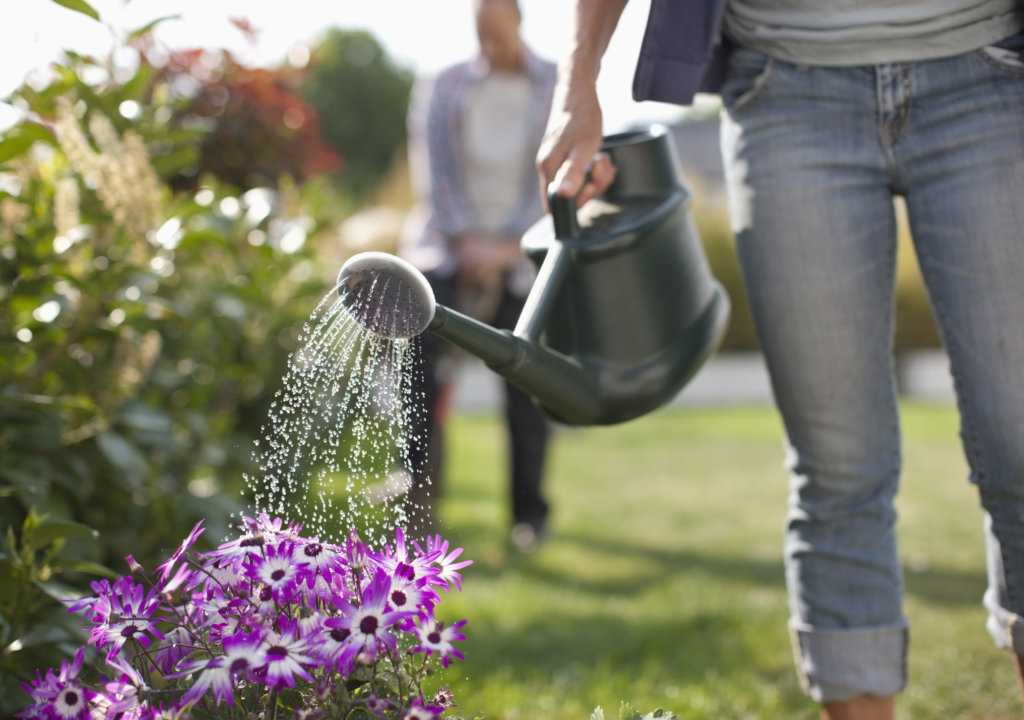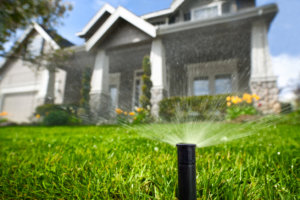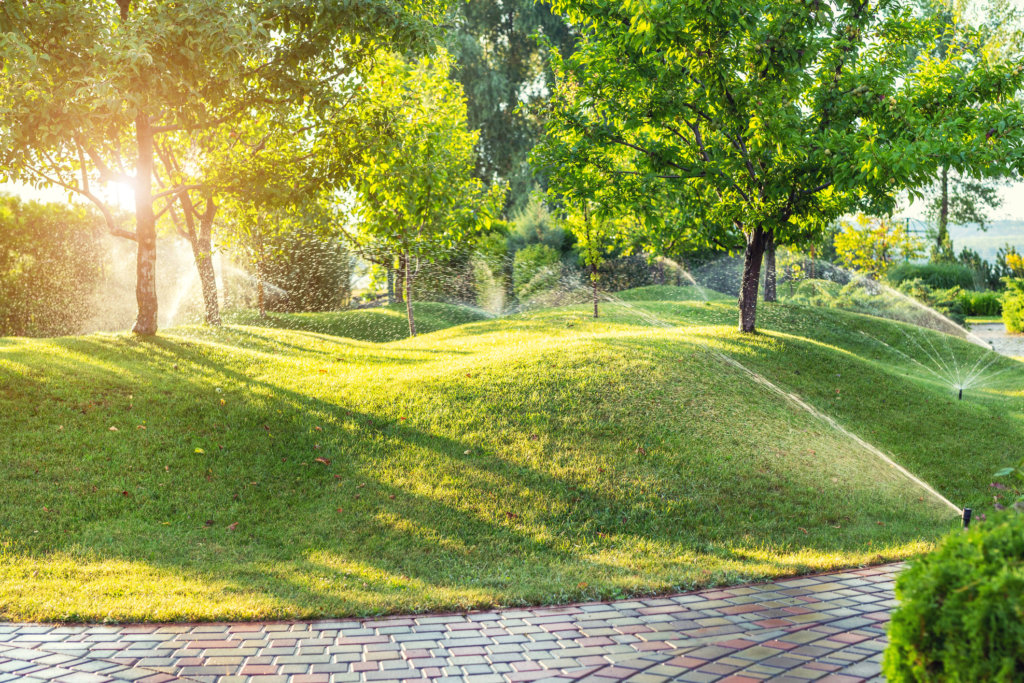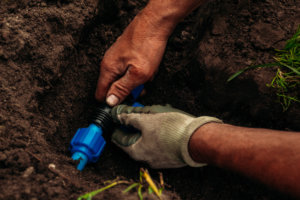
Everything You Need to Know About Irrigation Systems
There are many out there who have considered installing an irrigation system in their Colorado homes but don’t quite know how or where to start or fear the cost of the investment may be too high. Landscapes are often a property’s largest water consumer and understanding water management practices is one of the biggest areas of opportunity that can positively impact your water bill.
Learning where you can save money and efficiently manage your water distribution will help you in the long run. A sprinkler system can help by running efficiently, and only giving your lawn what it needs, you can have a green, healthy lawn while cutting down on your water waste. As irrigation experts in Colorado, Environmental Designs can provide information about irrigation systems as well as deliver improved irrigation systems that ultimately save you thousands of dollars annually.

Through this guide, we will provide an understanding of what an irrigation system is, the benefits of what an irrigation system brings, the types there are, cost, things to consider along the way, and more. If you are looking to invest in your home, property, or selective area, and living in a time where saving and material scarcity is a common issue, an irrigation install can be an option to alleviate some of your expenses.

What Is an Irrigation System?
The purpose of an irrigation system is to aid in the watering of plants for their growth. These systems are commonly seen through landscaping and agriculture. There are many different uses, purposes, and scenarios where irrigation can prove to be effective. Whether you are looking to install in many different zones, to having xeric areas that may use a drip-point install, or even systems that react and disperse water according to weather changes, irrigation systems are beneficial not only for landscaping and plants but also for your wallet and the environment. This all comes down to your needs.
For example, modern smart Irrigation systems use a Management Allowable Depletion rate. This helps figure out the best time to irrigate the roots because of increased surface evaporation and high transpiration that is associated with the frequency of irrigation. Many systems use different integration and timing pieces for the irrigation system, you just have to find out what works best for you.
Here is some basic terminology that will come in handy when talking about irrigation:
- Evaporation: Water that moves from the soil or plant surfaces in the atmosphere.
- Transpiration: Water that moves from the soil, through the plant, and into the atmosphere
Benefits of Irrigation Systems
Water management is as essential to your landscape as proper sun exposure and fertilization. One of the most obvious benefits of an irrigation system is the benefits it provides for your environment. Protecting your yard, plants, and trees from inefficient watering and drought. A well-designed system ensures that your grass and plants are getting the proper water distribution. Avoiding things like run-offs and providing deep feeding as needed.
- Financial aspect: One advantage irrigation systems bring is the financial benefit. By being able to adjust how much water is distributed and being able to schedule when it disperses, it helps save money and time.
- Distribution: Distribution uniformity is a key benefit in irrigation systems. Being able to consistently water specific areas, can help avoid underwatering and overwatering. For example, with distribution, you can manage watering different areas or zones around your house. This helps manage weed control and watering efficiency in your area.
- Nutrient Preservation and plant growth in the soils: This is something that is often overlooked. Overwatering and runoff are factors that can lead to drowning your plants, which washes away essential nutrients from the soil. When watering, be sure to see if your plant requires deep feeding or grows better with a smaller sporadic watering schedule.
Putting everything together, these beneficial pieces bring continuous value to you and your home. Being able to maintain a healthy lawn, keep your trees and plants watered consistently, and having the convenience of a system that waters for you, is an instant plus.
Types of Irrigation Systems
There are many types of irrigation systems out there; giving you options on how you want to keep your landscapes hydrated. All serve the same purpose but carry different functions and efficiencies. Each system has pros and cons to consider. The most common types of irrigation include:
Smart Systems
Pros:
- With the use of wireless sensors, the internet, and smart controllers, the system communicates with weather applications to adjust watering schedules for real-time conditions.
- Allows for adjustments accordingly through your phone or device in case you are away from your home.
- Auto-adjusting irrigation schedules based on the amount of evaporation and transpiration being distributed in your area
- Detects water depletion amounts, plant types, soil composition, rainfall, and forecasts to plan to water accordingly
- Can help with basic information about how much water you should apply, and what zone coverage you are wanting to reach
Cons:
- Can become difficult when trying to link software and technologies to other brands
- Internet is essential, and having a weak signal can be detrimental
- Depending on the size of your property, the cost of a smart system installation can be costly but will be a great investment in the long run.
Sprinkler System
Pros:
- Distribution for this system is fairly even
- Affordable and simple to install
- Can efficiently cover a large amount of ground
- Scheduling and distribution can easily be set to meet your demands
Cons:
- Nozzles are prone to clogging if water quality is not up to par
- Sprinkler heads require maintenance over a certain time
- Weather can affect the disbursement of the water, so be wary of water loss
Pros:
- Water quality remains high
- Reduced nutrient leaching due to optimal fertilization and a more efficient flow
- Land grading is not required
- Water-efficient because the system is built to minimize evaporation
- Tubing is very flexible and can conform to complex areas and shapes
Cons:
- Specified water content is required to be checked as drip irrigation systems can be easily clogged
- Constant maintenance is required to prevent flows and clogs
- Tubing is very fragile against mowers, trimmers, bugs, and rodents

Simplify Your System
There’s a plethora of resources and tools to help improve irrigation. For example, a thoughtful way to prevent overwatering is to install a smart irrigation controller to override automatic watering systems when necessary. Once a designated amount of water has been detected, it shuts down any regularly scheduled irrigation. These controllers are small, simple devices and are generally easy to install. They can measure out exactly how much water your plants are receiving and thus offer greater water savings.
Cost
The questions that always arise are “How much does an irrigation install cost?” Or “What can I expect to spend?”. Truth be told it depends; many factors come into play, such as how many zones you are looking to install, the size of the area that needs coverage, and any other complexities that may need to be addressed. With so many factors involved, it is best to get an irrigation professional to come out and give you an estimate. With an in-house team of irrigation specialists and professionals, we can provide and assist you with everything you need to know about an irrigation install and the cost of it all.
There are several options for irrigation installs if getting it done professionally does not align with your needs. There are many kits and DIY options that are simple and can be installed with some elbow grease and very few tools needed. You can look to spend anywhere from $40-$350 for your very own buildable install. This can be a cost-efficient project if you are looking to go down that route. The drawbacks of DIY projects are knowledge and tools. Yes, the process may be cheaper, but if you don’t have the necessary tools or materials or previous knowledge, things might get rugged. For example, if you were to trench and you accidentally hit a line, the labor might become tedious and dangerous. There are many options out there for anyone looking to get a professional install or learn how to do an install of your own.
Things to Consider
When deciding what kind of irrigation system, you would like installed, be sure to review the following.
Environmental Factors:
Be sure to check the soil of your area and the shape and structure of your area. Depending on if you have clay, sandy, or a mix of soils, the amount of moisture that the ground can hold will vary. In Colorado, generally, we deal with clay loam.
Along with areas that are sloped or peak, running the lines can become a challenge. Some lines would have to be adjusted accordingly to the shape of the land to avoid run-off issues. Our soils won’t absorb ¼ inch of water at a time. So we recommend that this should be spread out; watering 1/8 inch of water at a time, this helps efficiently disperse water through a cycle and avoid a runoff.
Weather Factors:
Depending on your area the weather is dry, arid, windy, or full of moisture, these are things to take into account. This way you can plan your irrigation accordingly to avoid things like evaporation, underwatering, and water loss.
Performance Factors:
Spacing, flow, and pressure are key to having the most uniform distribution available when keeping your areas healthy. Other things that are considered when measuring the performance of your irrigation systems are application depth, the application rate, and the infiltration.
There must be a good balance within the intensity of your irrigation. Dynamic pressure is one thing that helps the water flow continuously. Helps contribute to even water distribution so you don’t have irregular pressure within the heads of your nozzles. We recommend using MP Rotator as there is a better flow pattern, higher adjustment capabilities are available, and there is a lower evaporation rate. Some factors to be aware of if you start losing pressure in your nozzles can be caused: Tree roots, Fittings, Heads, Altitude, Length, and Friction in Pipes.
Be sure to always check your valves so you know that there is supple head drainage and reduce any puddle build-ups and runoff. We recommend using SAM heads; they are recognized for helping maintain pressure and prevent misting and fogging. As they say, save more and waste less.
Plant Type and Water Quality:
Different systems work well for different types of plants as the amount of feeding can vary, where they grow and how they grow.
With the different irrigation systems, many of these can require filtering to avoid clogs, pathogens, and any other solubles that can interfere with the growth of your landscape species. Always be aware of the water quality you are dispersing and if your systems are working appropriately.
Let Us Handle Your Irrigation in Colorado
One of the many services that we provide is an irrigation audit. We can do this for residential and commercial customers. Our team of professionals can help you determine an irrigation system based on the needs of your specific landscape. Not only will we give you our recommendation, but we’ll also perform any maintenance or upgrades ourselves.
Our team of Landscape Industry Certified Technicians can help identify and recommend the most efficient water usage, repairs, and upgrades. Contact us to learn more about upgrading your system and schedule an irrigation audit so you can start saving!


